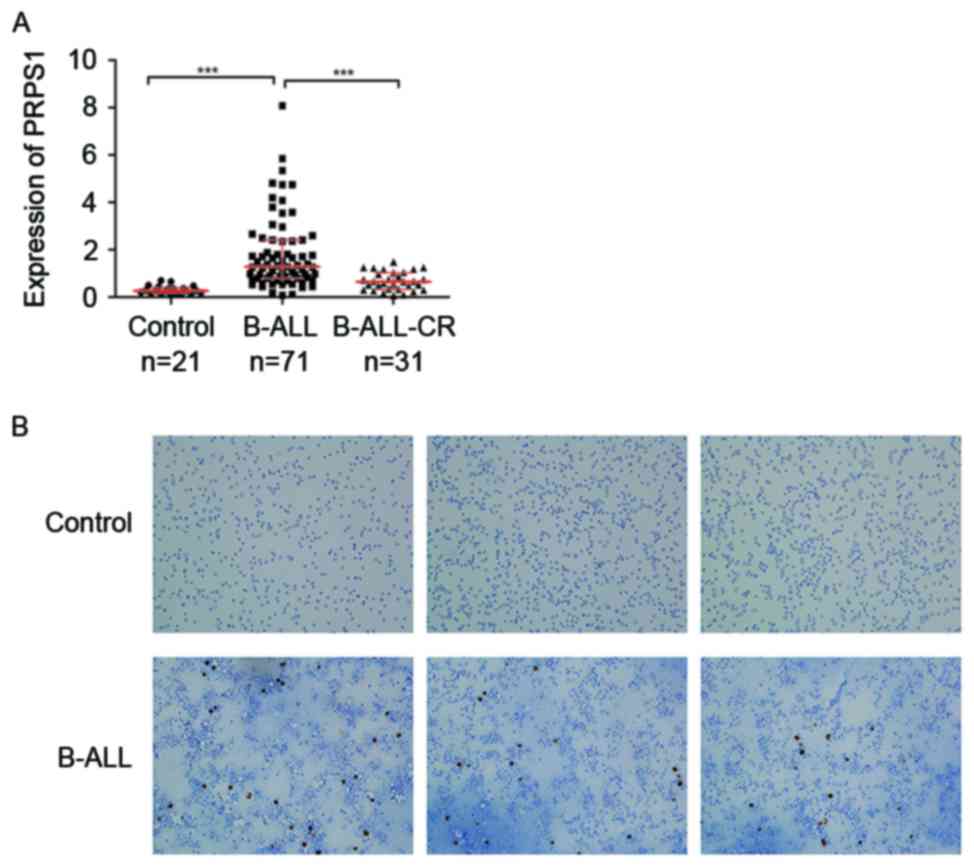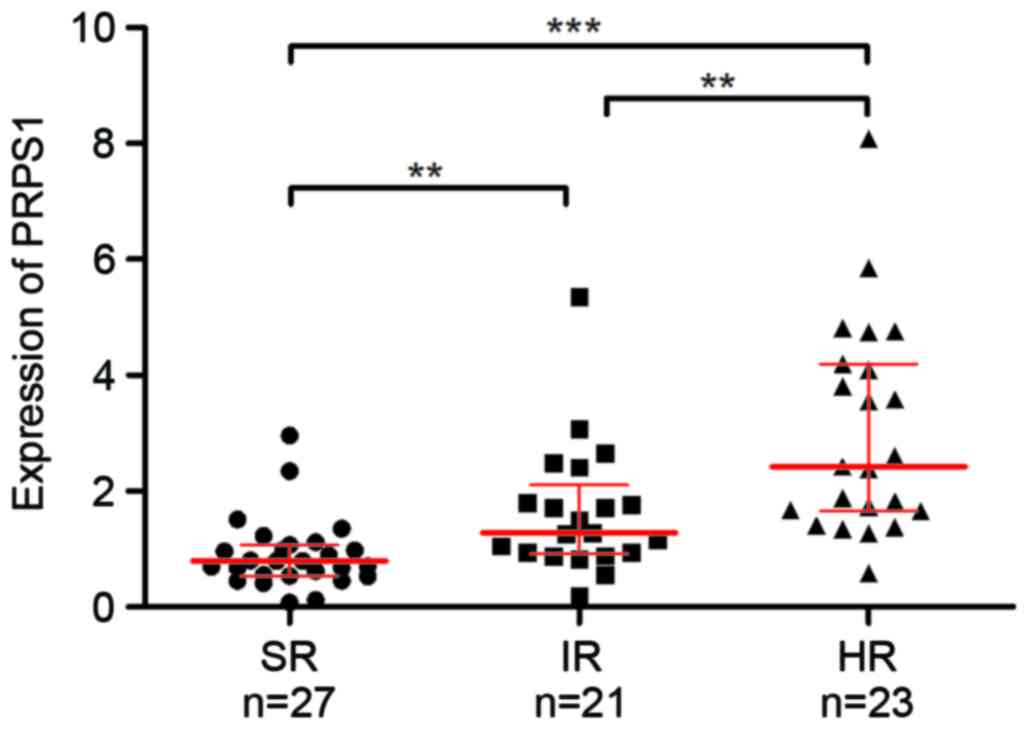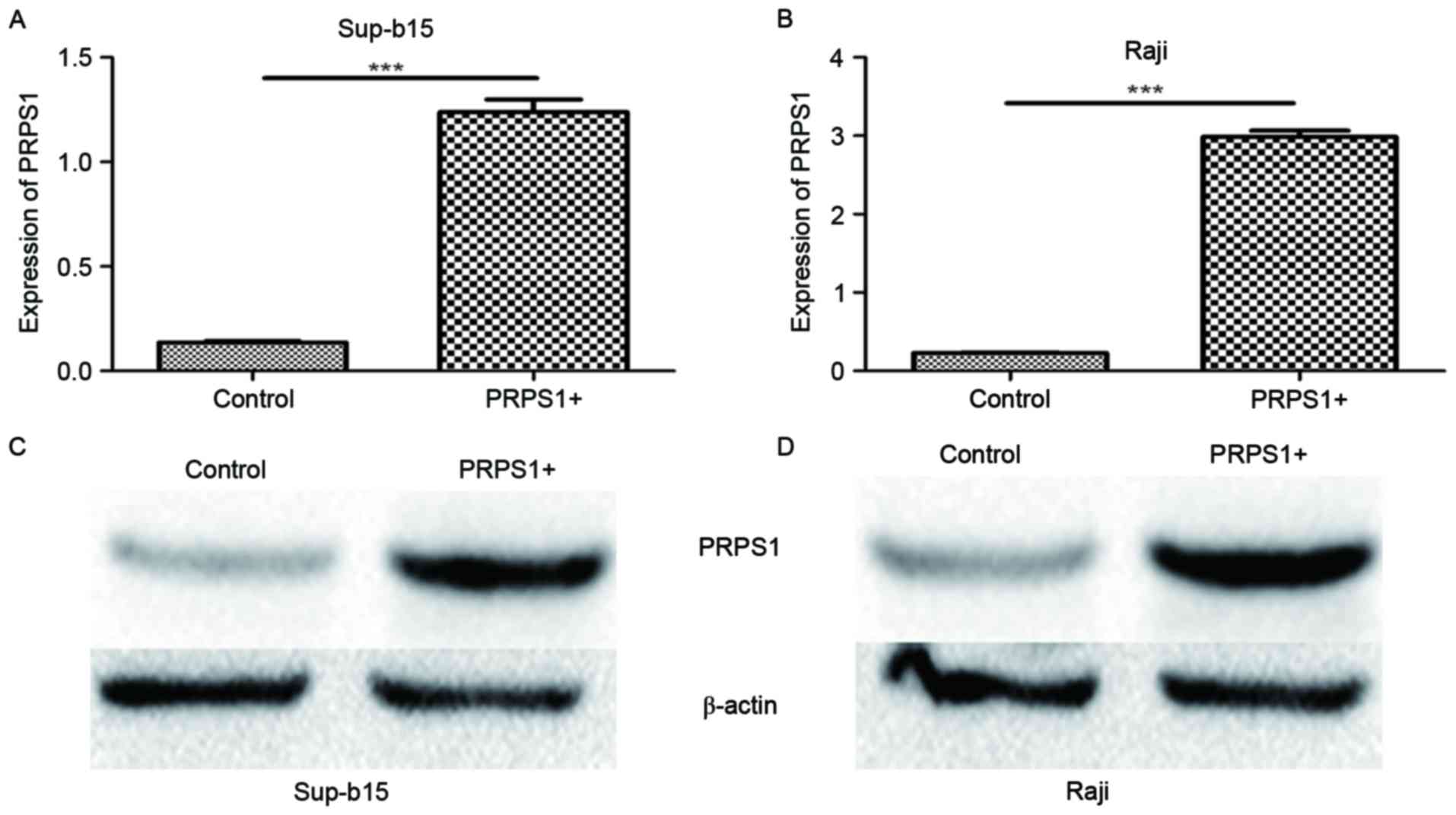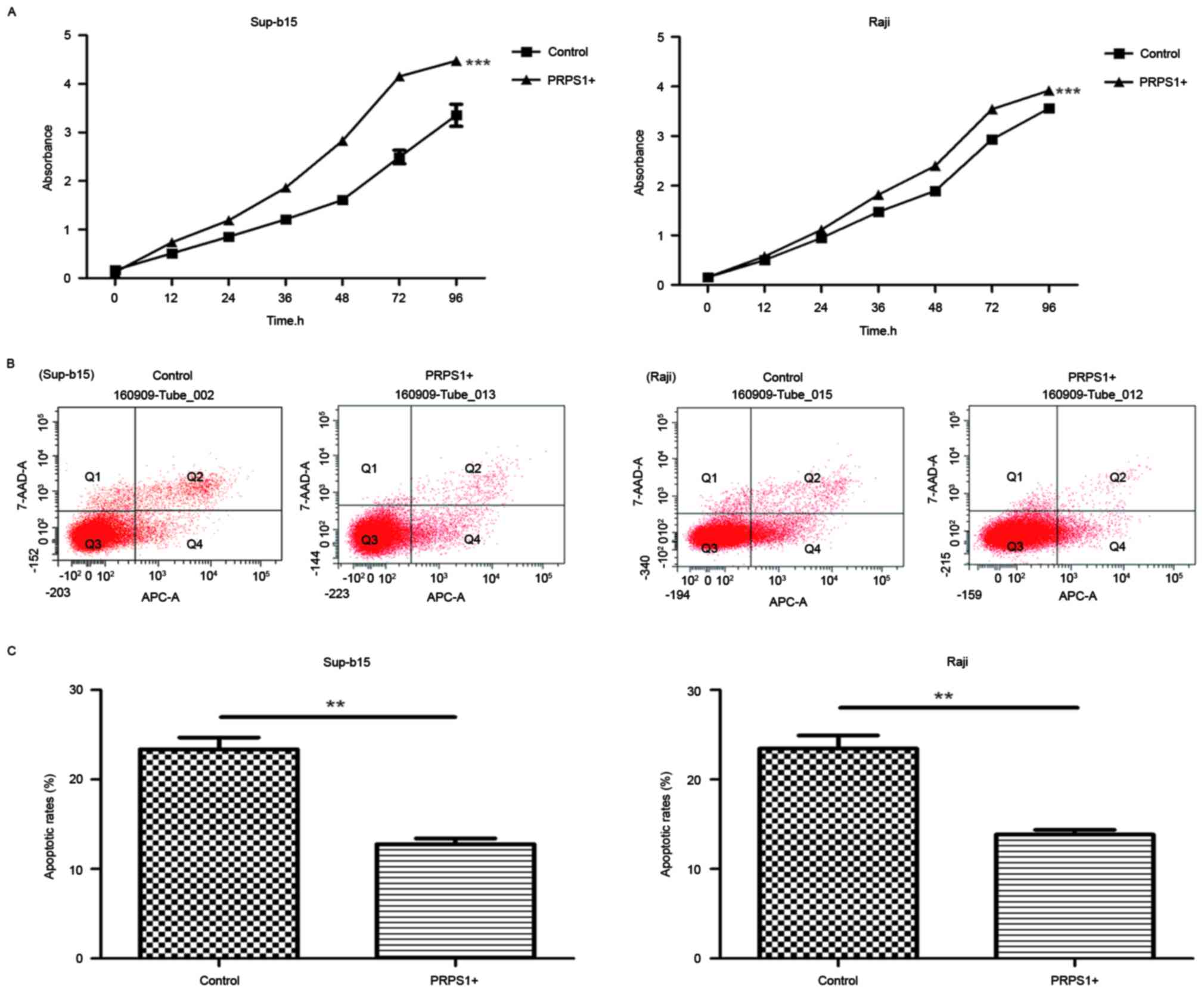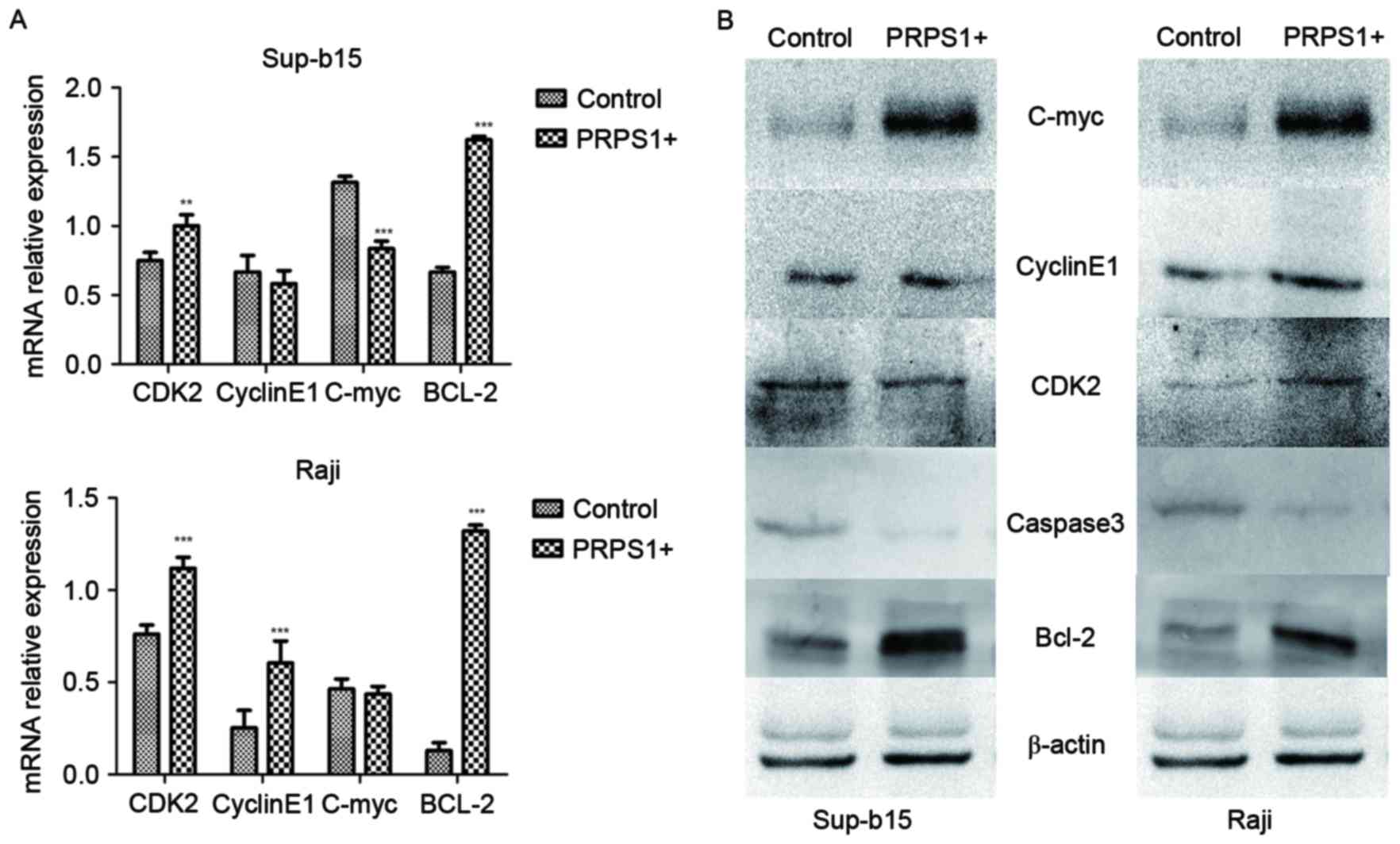|
1
|
Brisson GD, Alves LR and Pombo-de-Oliveira
MS: Genetic susceptibility in childhood acute leukaemias: A
systematic review. Ecancermedicalscience. 9:5392015. View Article : Google Scholar : PubMed/NCBI
|
|
2
|
Inaba H, Greaves M and Mullighan CG: Acute
lymphoblastic leukaemia. Lancet. 381:1943–1955. 2013. View Article : Google Scholar : PubMed/NCBI
|
|
3
|
Hunger SP, Lu X, Devidas M, Camitta BM,
Gaynon PS, Winick NJ, Reaman GH and Carroll WL: Improved survival
for children and adolescents with acute lymphoblastic leukemia
between 1990 and 2005: A report from the children's oncology group.
J Clin Oncol. 30:1663–1669. 2012. View Article : Google Scholar : PubMed/NCBI
|
|
4
|
Zhang F, Patel DM, Colavita K, Rodionova
I, Buckley B, Scott DA, Kumar A, Shabalina SA, Saha S, Chernov M,
et al: Arginylation regulates purine nucleotide biosynthesis by
enhancing the activity of phosphoribosyl pyrophosphate synthase.
Nature Commun. 6:75172015. View Article : Google Scholar
|
|
5
|
Turner RN, Aherne GW and Curtin NJ:
Selective potentiation of lometrexol growth inhibition by
dipyridamole through cell-specific inhibition of hypoxanthine
salvage. Br J Cancer. 76:1300–1307. 1997. View Article : Google Scholar : PubMed/NCBI
|
|
6
|
Sessa C, de Jong J, D'Incalci M, Hatty S,
Pagani O and Cavalli F: Phase I study of the antipurine antifolate
lometrexol (DDATHF) with folinic acid rescue. Clin Cancer Res.
2:1123–1127. 1996.PubMed/NCBI
|
|
7
|
Laohavinij S, Wedge SR, Lind MJ, Bailey N,
Humphreys A, Proctor M, Chapman F, Simmons D, Oakley A, Robson L,
et al: A phase I clinical study of the antipurine antifolate
lometrexol (DDATHF) given with oral folic acid. Invest New Drugs.
14:325–335. 1996. View Article : Google Scholar : PubMed/NCBI
|
|
8
|
Wedge SR, Laohavinij S, Taylor GA, Boddy
A, Calvert AH and Newell DR: Clinical pharmacokinetics of the
antipurine antifolate (6R)-5,10-dideaza-5,6,7,8-tetrahydrofolic
acid (Lometrexol) administered with an oral folic acid supplement.
Clin Cancer Res. 1:1479–1486. 1995.PubMed/NCBI
|
|
9
|
Pei W, Xu L, Varshney GK, Carrington B,
Bishop K, Jones M, Huang SC, Idol J, Pretorius PR, Beirl A, et al:
Additive reductions in zebrafish PRPS1 activity result in a
spectrum of deficiencies modeling several human PRPS1-associated
diseases. Sci Rep. 6:299462016. View Article : Google Scholar : PubMed/NCBI
|
|
10
|
Maruyama K, Ogaya S, Kurahashi N, Umemura
A, Yamada K, Hashiguchi A, Takashima H, Torres RJ and Aso K: Arts
syndrome with a novel missense mutation in the PRPS1 gene: A case
report. Brain Dev. 38:954–958. 2016. View Article : Google Scholar : PubMed/NCBI
|
|
11
|
Mittal R, Patel K, Mittal J, Chan B, Yan
D, Grati M and Liu XZ: Association of PRPS1 mutations with disease
phenotypes. Dis Markers. 2015:1270132015. View Article : Google Scholar : PubMed/NCBI
|
|
12
|
Gandia M, Fernández-Toral J, Solanellas J,
Domínguez-Ruiz M, Gómez-Rosas E, Del Castillo FJ, Villamar M,
Moreno-Pelayo MA and Del Castillo I: Mutations in PRPS1 causing
syndromic or nonsyndromic hearing impairment: Intrafamilial
phenotypic variation complicates genetic counseling. Pediatr Res.
78:97–102. 2015. View Article : Google Scholar : PubMed/NCBI
|
|
13
|
Almoguera B, He S, Corton M, Fernandez-San
Jose P, Blanco-Kelly F, López-Molina MI, García-Sandoval B, Del Val
J, Guo Y, Tian L, Liu X, et al: Expanding the phenotype of PRPS1
syndromes in females: neuropathy, hearing loss and retinopathy.
Orphanet J Rare Dis. 9:1902014. View Article : Google Scholar : PubMed/NCBI
|
|
14
|
Robusto M, Fang M, Asselta R, Castorina P,
Previtali SC, Caccia S, Benzoni E, De Cristofaro R, Yu C, Cesarani
A, et al: The expanding spectrum of PRPS1-associated phenotypes:
Three novel mutations segregating with X-linked hearing loss and
mild peripheral neuropathy. Eur J Hum Genet. 23:766–773. 2015.
View Article : Google Scholar : PubMed/NCBI
|
|
15
|
Li B, Li H, Bai Y, Kirschner-Schwabe R,
Yang JJ, Chen Y, Lu G, Tzoneva G, Ma X, Wu T, et al: Negative
feedback-defective PRPS1 mutants drive thiopurine resistance in
relapsed childhood ALL. Nat Med. 21:563–571. 2015. View Article : Google Scholar : PubMed/NCBI
|
|
16
|
Hassan K, Bukhari KP, Zafar A, Malik MZ
and Akhtar MJ: Acute leukaemia in children-French-American-British
(FAB) classification and its relation to clinical features. J Pak
Med Assoc. 42:29–31. 1992.PubMed/NCBI
|
|
17
|
Vardiman JW, Thiele J, Arber DA, Brunning
RD, Borowitz MJ, Porwit A, Harris NL, Le Beau MM,
Hellström-Lindberg E, Tefferi A and Bloomfield CD: The 2008
revision of the world health organization (WHO) classification of
myeloid neoplasms and acute leukemia: Rationale and important
changes. Blood. 114:937–951. 2009. View Article : Google Scholar : PubMed/NCBI
|
|
18
|
Cui L, Gao C, Zhang RD, Jiao Y, Li WJ,
Zhao XX, Liu SG, Yue ZX, Zheng HY, Deng GR, et al: Low expressions
of ARS2 and CASP8AP2 predict relapse and poor prognosis in
pediatric acute lymphoblastic leukemia patients treated on China
CCLG-ALL 2008 protocol. Leuk Res. 39:115–123. 2015. View Article : Google Scholar : PubMed/NCBI
|
|
19
|
He M, Chao L and You YP: PRPS1 silencing
reverses cisplatin resistance in human breast cancer cells. Biochem
Cell Biol. 95:385–393. 2017. View Article : Google Scholar : PubMed/NCBI
|
|
20
|
Livak KJ and Schmittgen TD: Analysis of
relative gene expression data using real-time quantitative PCR and
the 2(-Delta Delta C(T)) method. Methods. 25:402–408. 2001.
View Article : Google Scholar : PubMed/NCBI
|
|
21
|
Hanahan D and Weinberg RA: Hallmarks of
cancer: The next generation. Cell. 144:646–674. 2011. View Article : Google Scholar : PubMed/NCBI
|
|
22
|
Peter ME, Hadji A, Murmann AE, Brockway S,
Putzbach W, Pattanayak A and Ceppi P: The role of CD95 and CD95
ligand in cancer. Cell Death Differ. 22:885–886. 2015. View Article : Google Scholar : PubMed/NCBI
|
|
23
|
Lopez J and Tait SW: Mitochondrial
apoptosis: Killing cancer using the enemy within. Br J Cancer.
112:957–962. 2015. View Article : Google Scholar : PubMed/NCBI
|
|
24
|
Ola MS, Nawaz M and Ahsan H: Role of Bcl-2
family proteins and caspases in the regulation of apoptosis. Mol
Cell Biochem. 351:41–58. 2011. View Article : Google Scholar : PubMed/NCBI
|
|
25
|
Murphy KM, Ranganathan V, Farnsworth ML,
Kavallaris M and Lock RB: Bcl-2 inhibits Bax translocation from
cytosol to mitochondria during drug-induced apoptosis of human
tumor cells. Cell Death Differ. 7:102–111. 2000. View Article : Google Scholar : PubMed/NCBI
|
|
26
|
Becker MA: Phosphoribosylpyrophosphate
synthetase and the regulation of phosphoribosylpyrophosphate
production in human cells. Prog Nucleic Acid Res Mol Biol.
69:115–148. 2001. View Article : Google Scholar : PubMed/NCBI
|
|
27
|
Yamada Y, Yamada K, Nomura N, Yamano A,
Kimura R, Naiki M, Fukushi D, Wakamatsu N, Taniguchi A, Yamaoka N,
et al: Molecular analysis of X-linked inborn errors of purine
metabolism: HPRT1 and PRPS1 mutations. Nucleosides Nucleotides
Nucleic Acids. 30:1272–1275. 2011. View Article : Google Scholar : PubMed/NCBI
|
|
28
|
de Brouwer AP, van Bokhoven H, Nabuurs SB,
Arts WF, Christodoulou J and Duley J: PRPS1 mutations: four
distinct syndromes and potential treatment. Am J Hum Genet.
86:506–518. 2010. View Article : Google Scholar : PubMed/NCBI
|
|
29
|
Kim S, Nam SJ, Kwon D, Kim H, Lee E, Kim
TM, Heo DS, Park SH, Kim CW and Jeon YK: MYC and BCL2
overexpression is associated with a higher class of memorial
sloan-kettering cancer center prognostic model and poor clinical
outcome in primary diffuse large B-cell lymphoma of the central
nervous system. BMC Cancer. 16:3632016. View Article : Google Scholar : PubMed/NCBI
|
|
30
|
Cabrera Ortega AA, Gonçalves Vde P,
Guimarães MR, Rossa Junior C and Spolidorio LC: Overexpression of
Bcl-2, SOCS 1, 3 and Cdh 1, 2 are associated with the early
neoplasic changes in modified 4-nitroquinoline 1-oxide-induced
murine oral cancer model. J Oral Pathol Med. 45:573–580. 2016.
View Article : Google Scholar : PubMed/NCBI
|
|
31
|
Jager R, Herzer U, Schenkel J and Weiher
H: Overexpression of Bcl-2 inhibits alveolar cell apoptosis during
involution and accelerates c-myc-induced tumorigenesis of the
mammary gland in transgenic mice. Oncogene. 15:1787–1795. 1997.
View Article : Google Scholar : PubMed/NCBI
|
|
32
|
Hsu SY, Lai RJ, Finegold M and Hsueh AJ:
Targeted overexpression of Bcl-2 in ovaries of transgenic mice
leads to decreased follicle apoptosis, enhanced folliculogenesis,
and increased germ cell tumorigenesis. Endocrinology.
137:4837–4843. 1996. View Article : Google Scholar : PubMed/NCBI
|
|
33
|
Urtishak KA, Edwards AY, Wang LS, Hudome
A, Robinson BW, Barrett JS, Cao K, Cory L, Moore JS, Bantly AD, et
al: Potent obatoclax cytotoxicity and activation of triple death
mode killing across infant acute lymphoblastic leukemia. Blood.
121:2689–2703. 2013. View Article : Google Scholar : PubMed/NCBI
|
|
34
|
Kaida A, Ariumi Y, Baba K, Matsubae M,
Takao T and Shimotohno K: Identification of a novel
p300-specific-associating protein, PRS1
(phosphoribosylpyrophosphate synthetase subunit 1). Biochem J.
391:239–247. 2005. View Article : Google Scholar : PubMed/NCBI
|















